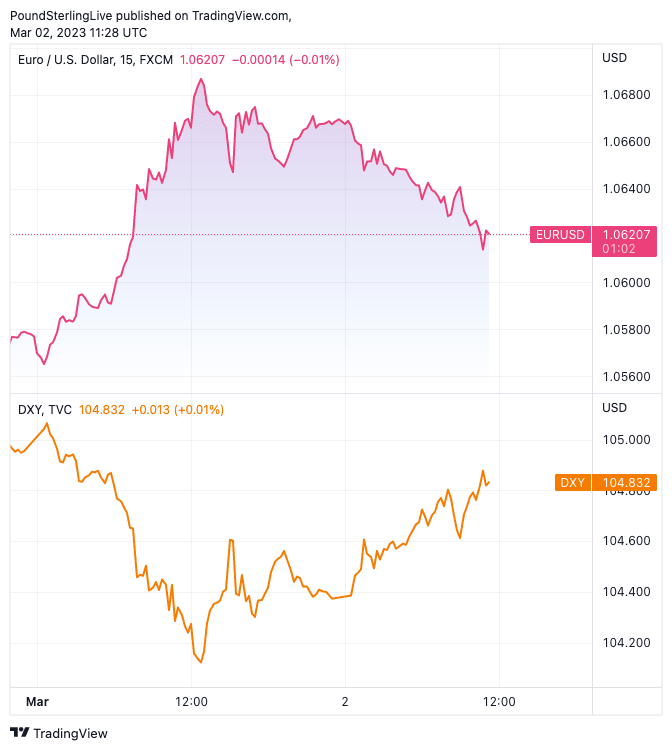Dollar Rebooted: XM.com
- Dollar drops on China PMIs
- But Fed hike bets increase on ISM PMI
- Prompting a rebound for the Greenback

Image © Adobe Images
The Dollar is in recovery mode following a soft start to March as investors react to some interesting U.S. data, says Charalampos Pissouros, Senior Investment Analyst at XM.com.
The US dollar traded lower or unchanged on Wednesday, losing the most ground against the kiwi, the euro and the aussie in that order.
Today, it is in recovery mode against all the other majors.
The greenback took the road south again yesterday, weighted by the stronger commodity-linked currencies kiwi and aussie, which received fuel from China’s better-than-expected PMIs.
The euro also added pressure to the dollar after preliminary data showed that German inflation accelerated instead of slowing further as the forecast suggested.
Later, dollar traders had to digest the less-than-expected increase in the US ISM manufacturing PMI, with the index rising from 47.4 only to 47.7 and staying in contractionary territory for the fourth straight month.
This may have weighed on soft-landing hopes and the dollar see-sawed.
On the contrary, Treasury yields rose and market participants further lifted their implied Fed funds rate path as the prices subindex of the ISM report jumped to 51.3 from 44.5, sparking fears that inflation may remain elevated for longer than previously thought, especially following the surge in the monthly CPI rate for January.
Hawkish remarks by Minneapolis Fed President Neel Kashkari and Atlanta Fed President Raphael Bostic may have also aided in lifting rate hike expectations.
Investors are now pricing in a terminal rate of almost 5.5% in September, while they see rates ending the year at around 5.4%.
This likely means the market is virtually certain that at the next gathering, Fed policymakers will revise up their “dot plot”, and especially the median dot for this year.
However, the reaction in the dollar has been somewhat muted, not fully reflecting the dramatic change in Fed hike expectations.
That’s maybe because hike bets surrounding other major central banks, like the ECB, have also increased radically.
On top of that, ahead of the next Fed gathering, investors will have to digest the employment and CPI reports for February, and that’s maybe why it is still premature to call for a long-lasting recovery in the US currency.
Above: The EUR/USD (top) and the Dollar index, showing March trade.
ECB Expectations Elevated
Most ECB officials have been appearing in hawkish suits lately, arguing about more bold action to tame inflation, specifically expressing concerns about how sticky underlying price pressures have become.
Market participants are indeed convinced that the ECB will need to continue more aggressively. They are currently assigning a 30% probability for a 75bps hike at the next meeting, with the remaining 70% pointing to the telegraphed 50bps increment.
Ergo, an upside surprise in today’s inflation numbers could increase the probability for a triple hike and further support the euro.
However, with the dollar also having the potential to make a comeback due to rising Fed bets, things for euro/dollar traders may be complicated.
Perhaps both the euro and the dollar could perform better against the loonie as the BoC is nearly certain that it will refrain from pushing the hike button when it meets next week.
Stocks Slide
The disappointing ISM manufacturing PMI print combined with increasing Fed hike expectations proved a toxic blend for Wall Street.
Although the Dow Jones closed Wednesday's session virtually unchanged, both the S&P 500 and the Nasdaq fell, with the latter losing the most due to its probably bigger sensitivity to Fed rate expectations.
This comes to confirm the view that even if equities rise during risk-on episodes, it is hard to envision indices heading towards their record highs.
Anything that adds to speculation of a more aggressive Fed is exerting pressure on equities as higher rates mean higher borrowing costs and lower valuations for firms.
From a technical standpoint, the Nasdaq is back below the 12,050 territory, which acted as the neckline of a previously completed double bottom, so the chances for a meaningful rebound henceforth have significantly lessened.
Charalampos Pissouros is a Senior Investment Analyst at XM.com. The original article can be viewed here.






